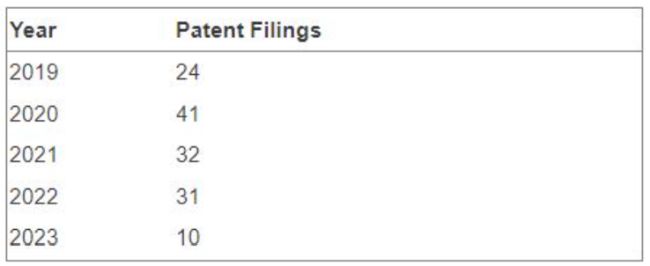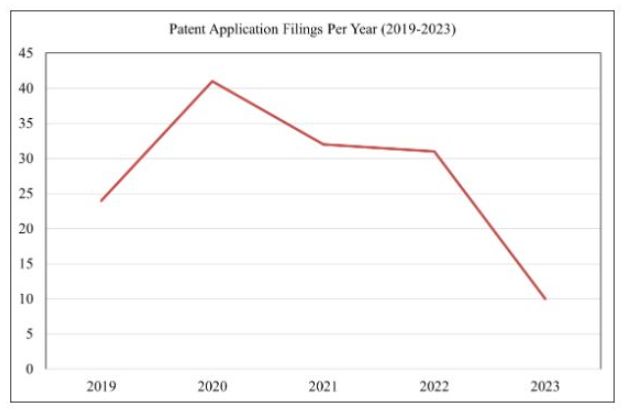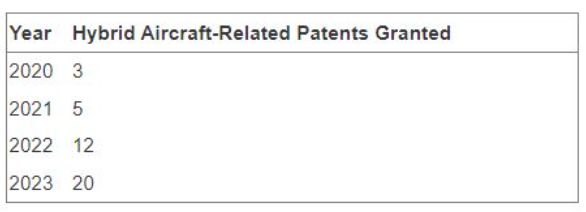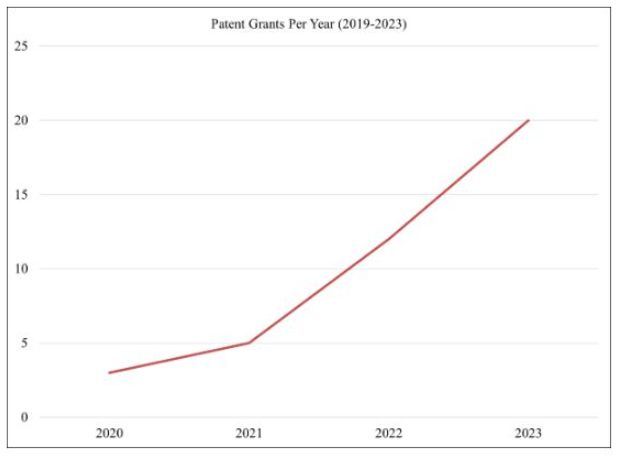Companies in the aviation sector are working to reduce fossil fuel consumption and carbon emissions to create more sustainable flights, largely via electrification.
Though all-electric commercial aircraft are not yet viable, key players in the aerospace industry have already begun developing hybrid systems and components that rely more heavily on electricity and sustainable fuels, rather than fossil fuel.
Many of these patent applications specifically cover hybrid-electric propulsion systems, but electric motors and improved energy storage technology also form a significant portion of these applications.
This article explores these patent trends in aerospace electrification and discusses areas of interest for future research given the current patent landscape.
Overview of Aerospace Electrification
Aerospace electrification generally refers to replacing traditional aircraft components that burn fossil fuels — such as engines and propulsion systems — with all-electric or hybrid systems.
In one example, hybrid-electric propulsion systems may include internal combustion engines supported by electric motors and batteries. Aircraft electrification is driven by various factors, including reducing costs, noise and carbon emissions, as well as a growing regional travel market that can be satisfied using short-range hybrid aircraft.1
A major player in the aviation industry, Collins Aerospace Inc., estimates that by replacing traditional propulsion systems with hybrid and all-electric components, it can reduce aircraft noise by up to 85%, reduce fuel consumption by 30%, reduce carbon emissions by 20% and reduce airline operating and maintenance costs by 20%.2
On a smaller scale, startup Ampaire Inc., which focuses on developing hybrid-electric aircraft, projects that its 15-passenger aircraft would decrease fuel costs by 90%, reduce maintenance costs by 50% and reduce noise by 60%.3
Electrification also serves to promote further use of severely underused regional airports. The NASA Regional Air Mobility report published in 2021 indicates that of the over 5,000 airports in the U.S., only 30 — 0.6% — serve over 70% of all travelers.4
According to a 2023 National Renewable Energy Laboratory white paper, hybrid and electric aircraft may help to increase usage of the vast network of regional airports.5
According to a March 2023 report, experts valued the electric aircraft market at $8.8 billion and estimated it would grow to $37.2 billion by 2030.6 In a similar August 2023 report, experts valued the hybrid aircraft market at $1.2 billion and approximated it would grow to $13.2 billion by 2030.7
Driving this growth are advances in hybrid propulsion systems and electric motor and energy storage technology, as evidenced by the following patent trends.
Patent Trends
General Trends
Since 2019, companies in the aviation sector have filed at least 138 U.S. patent applications — and have been granted upward of 40 patents — directed at hybrid aircraft technologies, with RTX Corp., General Electric Co. and Rolls-Royce Holdings PLC filing the most applications.
The following chart illustrates patent filing trends from 2019 to 2023:

A graph visualizing the above data is included below.

And, granted patents related to hybrid aircraft technology have steadily increased since 2019, as shown in the chart below.

A graph visualizing the above data is included below.

The above charts and graphs illustrate general trends.
Meanwhile, each specific company focuses on different areas of aerospace electrification. The largest patent filers focus on hybrid-electric propulsion systems, hybrid aircraft control systems, and electric generators and motors.
RTX
Some of RTX's technologies incorporate hydrogen fuel cells, batteries and charging systems. Indeed, of RTX's 65 U.S. patent filings, 48 are directed at hybrid propulsion systems and associated components.
Hybrid-electric propulsion systems work by using an electric generator to extract mechanical power from one or more gas turbine engines and storing that electrical energy in one or more batteries. The stored energy can then be used either in flight to power an electric motor, which in turn drives a propeller, or during landing operations.
Hybrid-electric propulsion systems reduce fuel consumption because the electric motor can help drive other aircraft components that were previously powered by combustion engines.9
In June 2023, RTX successfully tested a 1-megawatt electric motor, to be combined with a thermal engine, which aims to increase fuel efficiency by 30%.10 To put these numbers into context, this motor will be integrated into a Dash 8-100 aircraft, which has a capacity to transport 39 passengers.11
While RTX's earlier hybrid-electric propulsion system filings focused on combining traditional fossil fuel-powered engines with electric motors to provide propulsion, RTX's more recent filings have focused on replacing traditional fossil fuels with liquid hydrogen.
This shift suggests RTX's focus on emissions because liquid hydrogen does not emit the same greenhouse gases that traditional fossil fuels do — liquid hydrogen's byproduct is water.12
One application in particular describes using hydrogen fuel cells to generate electricity, which in turns powers electrical components in the aircraft.13
In a hydrogen fuel cell, a catalyst at the anode separates hydrogen molecules into protons and electrons, which take different paths to the cathode. The electrons go through an external circuit, creating a flow of electricity.14
Rolls-Royce
Rolls-Royce filed 16 patents between 2019 and 2023, generally split between hybrid aircraft control systems and electric generators and motors.
Rolls-Royce's electric motors may be used in conjunction with hydrogen or engines that burn fossil fuels in hybrid-electric propulsion systems or may be used in all-electric aircraft.
Rolls-Royce's key goal for developing electric motors is to maximize the motor's power density, or the power output per kilogram of mass. Generators and motors with a power density of least 13 kilowatts per kilogram are required for the electrification of aviation.15
But, a powerful electric motor is not useful if it has a short service life or needs to constantly be repaired.
So, many of Rolls-Royce's patent filings are directed at improving heat dissipation to ensure a longer service life and streamlining electric motor service and repair.16
Unlike RTX's efforts, which are directed at larger-scale commercial flight, Rolls-Royce focuses on urban air mobility, in the form of electric motors for air taxis and electric vertical takeoff and landing, or eVTOL, vehicles.17
General Electric
Like RTX's, GE's focus has been on increasing efficiency in hybrid-electric propulsion systems, filing at least 11 patents on improving propulsion systems since 2019.
For example, GE filed a patent application to mitigate compressor stall, which is a local disruption of the airflow in the compressor of a gas turbine.18 GE is developing technology to direct an electric motor to add power or torque to the compressor to ensure continued operation without stall.
In another example, GE filed a patent directed at using an electric motor to increase rotational speed based on thrust demand.19
Thus, we can expect GE to continue to pursue patents directed at improving its hybrid-electric propulsion system technology and streamlining how electric motors and traditional fuel-burning components interact with one another.
Startups and Smaller Companies
In addition to GE, RTX and Rolls-Royce — which are all large, well-known companies in the aerospace industry — there are many smaller startups involved in the aerospace electrification space. These startups are pursuing vastly different hybrid technologies.
Companies such as Joby Aviation LLC and Archer Aviation Inc. operate in the eVTOL space.
For example, Archer filed for at least nine patents directed at eVTOL aircraft components since 2019, including systems for power distribution, maintaining battery temperature in flight, motor cooling and even the eVTOL aircraft itself. Joby filed patent applications on similar technologies, including patents directed at vehicle cabin thermal management. Both Joby and Archer aim to begin commercial passenger service in 2025.20
Other startups, such as Verdego Aero, are focusing on perfecting power systems for hybrid aircraft, including developing technology to regulate battery temperature for on-board battery packs.21
Similarly, startup Ampaire, a pioneering hybrid-electric aircraft company, is focusing its efforts on developing lightweight battery packs for both all-electric and hybrid-electric aircraft.22
The Future of Hybrid-Electric Technology
Aerospace electrification is well underway.
A handful of blue-chip companies lead the charge for electrification of larger-scale commercial flights and searching for alternatives to fossil fuels to use in ever-developing hybrid-electric propulsion systems. Meanwhile, startups are advancing aerospace electrification on the regional scale through the development of intra-urban aircraft.
Regardless of specialty, however, companies are filing patent applications directed at improving energy storage and electric motor efficiency.
Storage and efficiency present critical obstacles in achieving mainstream all-electric or hybrid-electric flight. Those trends are likely to continue throughout 2024 and beyond.
Footnotes
1. National Renewable Energy Laboratory, Electrification of Aircraft: Challenges, Barriers, and Potential Impacts 5-6 (Oct. 2021), https://www.nrel.gov/docs/fy22osti/80220.pdf [hereinafter NREL White Paper].
2. Electrified Aircraft, Collins Aerospace, https://www.collinsaerospace.com/what-we-do/capabilities/electrified-aircraft (last visited Feb. 29, 2024). Collins Aerospace is a subsidiary of RTX Corporation.
3. NREL White Paper at 5; Ampaire; https://www.ampaire.com/ (last visited Mar. 18, 2024).
4. Id.
5. Id.
6. Electric Aircraft Market by platform (Regional Transport Aircraft, Business Jets, Light & Ultralight Aircraft), Type, System (Batteries, Electric Motors, Aerostructures, Avionics, Software), Technology, Application and Region – Forecast to 2030, Markets and Markets, https://www.marketsandmarkets.com/Market-Reports/electric-aircraft-market-52646445.html (last visited Mar. 1, 2024).
7. Hybrid Aircraft Market by Aircraft Type (Regional Transport Aircraft, Business Jets, Light Aircraft, UAVs, AAM), Power Source (Fuel Hybrid, Hydrogen Hybrid), Lift Technology, Mode of Operation, Range, System and Region – Forecast to 2030, Markets and Markets, https://www.marketsandmarkets.com/Market-Reports/hybrid-electric-aircraft-market-184129847.html (last visited Mar. 1, 2024).
8. Excluding applications filed with non-publication requests.
9. See generally The Power of Electric Flight, Collins Aerospace, https://www.collinsaerospace.com/news/stories/2021/09/power-of-electric-flight (last visited Mar. 1, 2024); see also Electrifying the Sky, Airbus, https://www.airbus.com/en/newsroom/stories/2023-03-electrifying-the-sky (last visited Mar. 1, 2024).
10. RTX advances hybrid-electric propulsion demonstrator with 1MW motor rated power milestone test, RTX Corporation, https://www.rtx.com/news/news-center/2023/06/19/rtx-advances-hybrid-electric-propulsion-demonstrator-with-1mw-motor-rated-power-m (last visited Mar. 1, 2024).
11. Id.; see also De Haviland Canada DHC-8 Dash 8, BAE Systems, https://www.baesystems.com/en/heritage/de-havilland-canada-dhc-8-dash-8 (last visited Mar. 14, 2024).
12. Hydrogen Benefits and Considerations, Alternative Fuels Data Center https://afdc.energy.gov/fuels/hydrogen_benefits.html (last visited Feb. 29, 2024).
13. U.S. Patent Application Publication No. 2024/0011436, claim 1, [0057].
14. Fuel Cells, United States Department of Energy, https://www.energy.gov/eere/fuelcells/fuel-cells (last visited Mar. 14, 2024).
15. Electric motors for aircraft, E-Mobility Engineering, https://www.emobility-engineering.com/electric-motors-aircraft/ (last visited Mar. 1, 2024).
16. See, e.g., U.S. Patent Application Publication No. 2021/0083542 (directed to an efficient electric motor); U.S. Patent Application Publication No. 2021/0159741 (directed to streamlining electric motor maintenance).
17. Electrification in aviation: Advanced Air Mobility solutions lead the way, Rolls-Royce, https://www.rolls-royce.com/products-and-services/electrical.aspx#urban-air-mobility (last visited Feb. 29, 2024).
18. U.S. Patent Application Publication No. 2022/0065175.
19. U.S. Patent Application Publication No. 2021/0172384.
20. Archer Aviation, https://www.archer.com/usher/ (last visited Mar. 14, 2024); Joby Aviation; https://www.jobyaviation.com/ (last visited Mar. 14, 2024).
21. U.S. Patent Application Publication No. 2022/0281351.
22. U.S. Patent Application Publication No. 2023/0187765.
Originally published by Law360
The content of this article is intended to provide a general guide to the subject matter. Specialist advice should be sought about your specific circumstances.


